We live in a fast-paced culture that can often lead to stress and burnout. We know disruptions are inevitable, but it’s how we respond and work through those challenges that matters. One of the best skills an organization can develop within its employees to manage workplace stress and disruption is organizational resilience. But what does the term mean exactly, and how can you take steps to develop this mindset?
In this post, we’ll answer those questions, explore characteristics of resilient organizations, and discuss how data is the key to navigating transformation and the skills needed to build a change-ready workforce.
What is Organizational Resilience?
The Essential Elements of a Resilient Organization
Characteristics of Resilient Organizations
How Can You Develop a Resilient Organization?
Examples of Organizational Resilience
Before we can address how resilience applies to an organization and how it can improve the lives of your employees, let’s talk about what the term means.
What is Organizational Resilience?
Organizational resilience refers to an organization’s ability to prepare for and respond to changes and challenges in order to thrive and grow. Science has proven that employees with high resilience are often less stressed, more productive at work, healthier, and less likely to quit:
– 31% more engaged
– 60% less likely to suffer burnout
– Four times more likely to have high job satisfaction.
The Essential Elements of a Resilient Organization
People, products, and processes are the three key components of an organizational ecosystem. The employees are the foundation of any business, and their resilience directly impacts the quality of products or services they produce and the dependability of processes within the organization.
Employee behavior determines whether a business is successful. In order to navigate what comes next, employees need to embrace physical, mental, and emotional health to remain adaptable and in control of their readiness. Empathetic leadership and a flexible workforce can create a mindset that thrives on change and enables everyone to work independently, but also contribute and perform as a collective team.
Independent, self-aware, and resilient behavior often empowers employees to lead by example. Employees rely on each other’s strengths and problem-solving skills to help navigate disruptions and challenges, which can contribute to better business growth and organizational preparedness.
Employees that practice the skills of resilience also have the ability to make necessary changes to their products or services in a timely, efficient manner. They are continually evaluating feedback and aren’t sidelined by change.
A resilient workforce is also critical to creating, implementing, and improving processes within an organization.
The bottom line? If your people aren’t resilient, your organization won’t be.
When the people, products, and processes efficiently and successfully work together — and you combine that with resilience data that provides cognitive competency insight and feedback — your organization can adjust as needed. This strategy has been proven to empower a mindset that emphasizes teamwork and collaboration, based on individual self-care and social support.
Characteristics of Resilient Organizations
How does your organization react and thrive to change and disruption? Common characteristics of resilient organizations include:
– Strong leadership. In resilient organizations, leadership is not just a title. Strong leaders put their employees first and seek long-term solutions that can improve workforce well-being and deliver meaningful business outcomes.
– A culture of well-being. “Change fatigue” contributes to a range of mental and physical issues, including anxiety and burnout. It’s important to create and maintain a culture of well-being that addresses physical, mental, and emotional health. For example, this could mean taking organization-specific steps to increase participation in wellness, behavioral health, or other related programs.
– Unifying human resources. An effective human resources team should not only work together within the department, but also with other thought leaders across the organization. They should communicate information and share common objectives so that everyone embodies the same goals and mindset.
– Understanding and mitigating risk. Data is crucial in helping an organization understand the pain points and challenges within the workforce. This helps organizations respond quickly and efficiently and take calculated risks when it comes to implementing programs and processes or adapting to disruption.
– Adaptive thinking. Similar to the rest of the world, the workplace is constantly changing, but the one constant in your organization is your employees. When employees can adjust quickly and modify their mindset, your organization is likely to successfully navigate any challenge.
– Investing in the total employee experience. Employees with low resilience have a mindset that’s adverse to change. Those employees may also suffer from anxiety or depression; when all of those factors are compounded by a crisis, employees will often struggle. Burnout becomes a heightened risk. Resilient organizations take the necessary steps to ensure total employee well-being from the start, including investing in the right preparedness tools and resources.
How Can You Develop a Resilient Organization?
Developing a resilient organization starts with involving the right people. Those employees in leadership, well-being and benefits, and talent and learning must come together to understand what kinds of challenges or problems they are trying to solve — and what resilience means to their organization.
Many organizations use an Employee Assistance Program (EAP), which is a work-based benefits resource that helps employees in all areas of their lives, including personal, professional, emotional, legal, and more. These programs typically offer a variety of services and support, such as mental health counseling, grief assistance, and more.
While EAPs are a valuable resource for employees, they are often underutilized and only leveraged when an employee is in crisis. In addition, EAPs, wellness programs, and mindfulness apps provide surface-level information because they aren’t based in cognitive behavior therapy or neuroscience. In other words, these types of programs are just a drop in the bucket. They don’t provide you with the real-time, scientific data needed to make meaningful changes within your organization.
A resilience platform partner takes a different, data-driven approach. With meQuilibrium, that data is based on years of neuroscience and Cognitive Behavioral Therapy. This type of program may be a good fit for your organization if you have concerns about the levels of stress, anxiety, and depression, or if you’re looking to improve productivity or participation rates in wellness and behavioral health programs. The difference is that we’re rooted in data and science.
The right resilience training solution will provide organizations with a scalable and science-backed digital approach that generates, gathers, and organizes employee feedback. You’ll be able to assess employees about their physical, mental, and emotional well-being, measure those outcomes, and see exactly where support is needed. An executive dashboard can provide data visualization in real time so you can predict what’s next and protect and support your employees with the right programs and processes in order to create and sustain a wholly resilient organization.
Examples of Organizational Resilience
Organizational resilience has helped many companies successfully prepare for and respond to changes and challenges in order to thrive and grow. Here are a few examples:
Tackling Stress & High Absenteeism
A Fortune 500 media and technology company that employs about 100,000 people nationwide experienced chronically high absenteeism rates among its call center staff. The company discovered that stress was the main cause for the absences, and this was an area where employees needed the most help.
While existing programs such as EAP, yoga, and meditation were helpful, participation rates were low. The company wanted an efficient, scalable way to help their employees manage stress, and they found it with meQuilibrium. The program began with an individual assessment and generated resilience profiles, and action plans were created for each user.
The results showed substantial reductions in stress and improved performance with resilience scores increasing by 8% and stress management scores increasing by 20%. The employees who engaged the most with the program saw a notable benefit in the reduction of absenteeism.
The Right Skills to Change and Manage Complexity
A global information technology and services company with more than 60,000 employees wanted to provide better resources to engage and perform in a transforming and stressful environment. The company decided to bring in the meQuilibrium solution to equip employees with a personalized approach to building resilience, and the program produced significantly positive results.
The company exceeded its goal for participation, and employees showed high participation rates in the core skill-building exercises. This was also apparent in the company’s resilience improvement, which showed increases in resilience indicators such as emotional control, burnout, and motivation.
Resilience Improves Engagement and Productivity in a High-Pressure Environment
A global financial services firm, despite being listed as one of Fortune’s 100 Best Companies to Work For, found itself experiencing high turnover rates and low productivity. The company’s leaders realized that the high-demand environment was negatively impacting the health, engagement, and performance of employees. They turned to meQuilibrium to help them equip their 3,000-employee workforce to better react to change and increased demands with the power of resilience.
After implementing the meQuilibrium engagement and performance solution, employees showed an encouraging 8% boost in resilience. This increase led directly to improvement in all eight outcomes related to employees’ ability to manage stress and adapt.
Want to Bring the Power of Resilience to Your Organization?
meQuilibrium builds, delivers, and supports the only clinically validated resilience building program on the market today. Our mission is to help both individuals and organizations unleash and realize their potential and achieve measurable improvements in well-being, adaptive capacity, purpose, and performance.
Let’s talk today to see for yourself how meQuilibrium works to build resilience in your organization.

